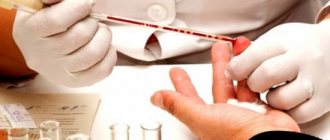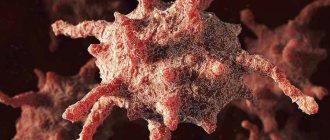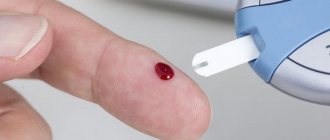High blood sugar is a pathology that can develop in every modern person. The reason for this is refined foods in stores, lack of constant physical activity, chronic stress and poor lifestyle in general.
In some cases, a person develops diabetes, but sometimes the increase in blood glucose turns out to be one-time and short-term. One way or another, sugar needs to be reduced, and for this it is permissible to resort to traditional medicine methods, which are also effective.
A quick way to reduce sugar
In no case should folk remedies be the only way to lower blood glucose levels, but they can be used as one of the components of treatment.
In addition, a situation can always arise in which the necessary remedy is not at hand, and the sugar level rises sharply. recipe can help : mix the juice of one lemon with 1 raw egg, drink it on an empty stomach and do not eat anything for an hour after.
You need to consume the lemon-egg mixture for 3 days in a row, one serving per day.
What foods lower sugar
Every person facing the problem of high blood sugar should know and include in their diet foods that have the ability to reduce its level:
Blueberry . It contains an insulin-like substance that is preserved both in fresh berries and in a decoction of its leaves. The decoction itself is prepared very simply - you need to pour a small spoonful of crushed blueberry leaves with a glass of boiling water and let it brew for half an hour. The resulting decoction is divided into three parts and drunk daily.
Cucumbers . In addition to containing the same insulin-like substance, cucumbers can well block the feeling of hunger and fight increased appetite in general.
Buckwheat . Can significantly reduce sugar levels when consumed regularly. It is recommended to include in your diet both simple boiled buckwheat in water and infused with kefir (the cereal is poured with a milk drink and left overnight).
Radish . Improves digestive functions, has a laxative effect, solves the problem of constipation and can reduce not only sugar, but also cholesterol. It is advisable to consume this vegetable fresh (salads) or freshly squeezed juice.
Chicory . Contains inulin, which has a beneficial effect on the pancreas and is generally very beneficial for the body. If you have high sugar levels, it is recommended to replace regular tea or coffee with chicory powder - prepare and drink like other drinks.
When it matters
For type 1 diabetes
Insulin-dependent diabetics inject a certain dosage of insulin for each carbohydrate consumed (expressed in bread units) so that it safely transports sugar into the cells and prevents its increase in the blood. However, they have restrictions on the daily intake of XE. The less of them a product contains, the more varied, healthy and balanced the diet will be.
Example. For breakfast, an insulin-dependent diabetic needs to take no more than 5 XE. You can prepare dumplings with cottage cheese (only 100 g for 3.17 XE) and drink a cup of coffee with milk (a little more than 1.5 XE). Another breakfast option for the same 5 XE: 150 g of oatmeal with milk for 2 XE, add berries and nuts to it (not even 0.5 XE), 20 g of whole grain bread with Russian cheese (1 XE) and the same cup of coffee with milk for 1.5 HE.
The second option is more varied, more satisfying, and most importantly, healthier for a diabetic. Yes, in the first case, it will not violate the norm of bread units, but at the same time: it will not receive vitamins, and the dumpling dough is a fairly fast carbohydrate. This means that it will provoke a small but sharp increase in blood sugar. Of course, insulin administered half an hour before breakfast will transport it into the cells and prevent hyperglycemia, but after an hour you will want to eat again. The cottage cheese and milk left to be digested in the stomach will not last long.
Slow carbohydrates and protein foods contain a small amount of bread units (per 100 g - less than 1 XE), allowing you to eat a varied and balanced diet. Therefore, knowing how to operate with this information, patients can stabilize their blood counts so that there are no surges in GLU. All you need to do is have the appropriate table in front of your eyes.
For type 2 diabetes
Insulin-dependent diabetics follow a stricter diet than non-insulin-dependent diabetics. If they can afford the breakfast given in the example above, then only if a number of conditions are met: low-fat cottage cheese, soy flour for making dumplings, oatmeal with water, and it is better to replace it with barley or barley porridge, berries only sour. Why is that?
In type 2 diabetes, the body produces too little insulin or the tissues cannot absorb sugar. Therefore, the patient’s task is to include in the diet something that does not contain carbohydrates at all (pure proteins) or so that they are as slow as possible. The rate of glucose release into the blood is reflected by the glycemic index. Ideally, the menu of a non-insulin-dependent diabetic should contain only those foods with a GI of less than 35 units. Occasionally you can enjoy those in which it is in the range of 40-50, but no more (see full tables of GI products here.
With adequate treatment and choosing the right foods, patients can significantly improve their quality of life. These two components ensure stable blood biochemistry, thereby determining the calm course of the disease, without attacks.
For hypoglycemia
At certain points, foods that lower blood sugar can seriously harm your health. If a person has a tendency to hypoglycemia, he should not limit his diet exclusively to protein foods. As soon as the glucose concentration drops, you must definitely eat something that will increase it to the normal level (a piece of sugar, sweet juice, candy). Low-carbohydrate diets are strictly contraindicated for such people.
Blood sugar levels
When losing weight
The diet of someone losing weight should be dominated by foods that lower blood sugar levels, because this indicator affects the processes of formation and breakdown of fat cells.
If it is normal, insulin is produced in moderate quantities and successfully copes with its function: transporting glucose from the blood into cells, where it is converted into useful energy.
If sugar is elevated and insulin is produced in large quantities, it still does not have time to transport glucose into the cells in a timely manner, since there is too much of it. And he has no choice but to send all the excess to the formation of reserves in the form of fat deposits.
Therefore, when losing weight, you need to focus on foods with a low GI, because they help lower blood sugar, stabilizing this indicator and preventing the formation of extra pounds:
- low GI ≤ 35 units (foods that reduce blood sugar and promote weight loss);
- average GI = 40-50 units (helping to stabilize sugar and weight, that is, keeping them at the same level);
- high GI ≥ 55 units (increasing sugar levels and contraindicated for weight loss, promoting weight gain).
Those who are losing weight can also use a nutrition system that calculates bread units, as with type 1 diabetes. However, there you need to significantly reduce the daily intake of XE (to 10-15 units) in order to get rid of extra pounds.
Diet
First of all, avoiding white bread, pastries and all sweet foods and drinks will help reduce blood glucose levels.
If diabetes has already been diagnosed, then the attending physician will set strict dietary restrictions, but if the increase in glucose is only a temporary concern, then you should start adhering to the following recommendations in advance:
- Any alcoholic drinks should be completely excluded.
- All spicy, salty, fried and fatty foods should be removed from the diet.
- You should exclude sweet fruits (grapes, bananas, etc.), potatoes, pasta, mushrooms, and pork from the menu. These foods cause a sharp spike in blood sugar.
- It is necessary to eat a lot of food rich in fiber - fresh vegetables, bran.
- The total caloric content of the diet should be reduced if possible.
- It is advisable to eat food in small portions, but often enough.
- Carbohydrate-rich foods should be consumed in the first half of the day.
- It is advised to replace regular bread with whole grain bread containing bran, and animal fats with vegetable fats.
- It is important to maintain a drinking regime: drink enough water per day.
Herbal decoctions
People suffering from high sugar have long been using decoctions of various medicinal herbs, which is not at all surprising. When choosing ways to reduce it, you can safely focus on medicinal plants. Preparing decoctions and tinctures at home is a fairly easy and quick process, and the result will not be long in coming.
The leaders among healing herbs that normalize glucose levels are the following:
- bay leaves, wormwood;
- dandelion roots, St. John's wort;
- immortelle officinalis;
- stinging nettle, clover, woodlice;
- birch buds, speedwell, burdock root;
- elderberry, rosehip or hawthorn fruit;
- walnut partitions and ground leaves;
- leaves of blackberries, strawberries, black currants, etc.
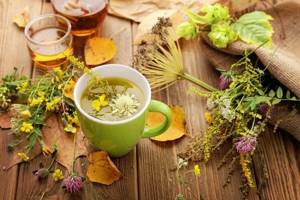
Medicinal plants to lower glucose
Reducing blood sugar with folk remedies prepared on the basis of the above plants occurs gradually and very gently, without causing negative side effects, for example, such as an excessive decrease in glucose. Also, other reactions such as skin rashes, itching or swelling are almost never observed.
The only thing that can become an obstacle to treatment with these remedies is individual intolerance to a plant, but it can always be replaced with another from the proposed list. From them you can prepare all kinds of teas, infusions, decoctions and take them in the most convenient way. Below are a few recipes.
Measuring blood sugar with a glucometer
- Bay leaf. Take 8 leaves, wash them and pour 250 ml of boiling water. Leave in a thermos for at least a day, after which you should filter the broth. You need to take 60 ml 3 times a day half an hour before meals. The duration of treatment is 5 days.
- Dandelion roots. The collected plant roots must first be washed and then chopped. Pour one tablespoon of the resulting dry raw material into a thermos and add half a liter of boiled water. After the product has been infused for 2 hours, it must be strained and divided into 3 parts, which should be drunk throughout the day 20 minutes before each meal.
- Burdock root. The required part of the plant must be washed and grated on a coarse grater, so that 1 tbsp is obtained. spoon without a slide. Mix the raw materials with a glass of boiling water and simmer over low heat for at least 10 minutes. Then leave for about half an hour. Then strain, cool and consume 20 ml before breakfast, lunch and dinner.
Sugar substitutes
In cases where it is too difficult for a person to give up consuming sugar even with elevated levels in the blood, substitutes can come to the rescue.
The most famous is Aspartame, which is usually added to tea or coffee - it dissolves well in hot and cold water, contains no calories and has no side effects. Based on aspartame, a safe sweetener Argoslastin was created, even sweeter, but completely safe and has zero calories.
In turn, industrial fructose is difficult to dose, although it is sweeter than sugar, and in an overdose, this substitute leads to excess uric acid and triglycerides.
Long-term consumption of Xylitol impairs vision and causes dysfunction of the gastrointestinal tract, and Saccharin is not absorbed by the body, therefore it is completely prohibited in some countries.
Medicinal plants
Many plants not only have the ability to lower blood glucose levels, but even help in the initial stages of diabetes. However, before using them, it is better to consult with your doctor so that there is no conflict with the medications prescribed by him (in the case of already prescribed treatment) and to eliminate the risk of developing allergies.
The following medicinal herbs show the greatest effectiveness in reducing sugar:
Burdock . It has a choleretic, diuretic and diaphoretic effect on the body, and due to the removal of excess fluid, the glucose level also decreases. Burdock leaves and roots are suitable for brewing - you can buy them at the pharmacy or collect them by hand. The best option is ready-made burdock root extract.
Oats . To lower glucose levels, an infusion of oat straw is suitable, which should be drunk half a glass before each meal. If there is no straw, then you can infuse oat grains: both are poured with boiling water and kept.
Goat's rue . The roots of this plant contain a unique substance similar to human insulin - galequin. Goat's rue is even used to alleviate the condition in the first stages of diabetes, consumed as an infusion of herbs in boiling water.
Rhodiola rosea . Quite a strong remedy that needs to be taken drop by drop. To prepare the infusion, use strong alcohol - 50 g. Rhodiola roots are finely chopped, poured with 0.5 liters of vodka and infused in a dark place for a week. Take the resulting product 10 drops with water 3 times a day before meals.
Burnet . To lower blood sugar, the roots and leaves of this plant are used: from them a regular decoction is prepared from a teaspoon of herb to a cup of boiling water.
Vegetable juices
Many vegetable juices show good effectiveness in lowering blood glucose, but it is very important that they are freshly squeezed and consumed on an empty stomach 2 times a day.
Potato juice is considered especially effective in such cases - it should be consumed in half a mug 30 minutes before meals. It will also improve the digestive system.
Cabbage
In addition to containing a significant amount of fiber (very important for high sugar), white cabbage is able to remove excess fluid from the body and thereby lower glucose. It is also rich in vitamins, pectins and substances that can suppress the development of pathogenic bacteria in the body.
It is advisable to consume cabbage fresh, but cabbage juice can be an alternative.
Jerusalem artichoke
“Earth pear” has unique beneficial properties, which not only lower blood glucose levels, but also normalize the functioning of the gastrointestinal tract. In addition, Jerusalem artichoke eliminates the feeling of hunger and relaxes.
You can add fresh tubers to salads, after grating them, or consume Jerusalem artichoke in powder form. To prepare it, the “earthen pear” needs to be washed, finely chopped, ground and dried. In order to lower sugar, it is recommended to take 1 teaspoon of Jerusalem artichoke powder.
If diabetes has already been diagnosed and treatment is underway, regular consumption of Jerusalem artichoke tubers allows you to gradually reduce the required daily dose of insulin.
Operating principle
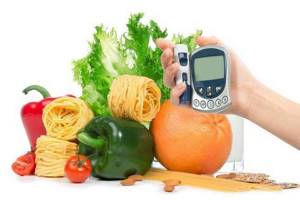
In order not to be deceived initially, you need to understand how these products affect the body and the processes occurring in it.
It’s important to understand right away that not a single product directly affects blood glucose. That is, he cannot bind, block and remove it from the body. Therefore, after eating a handful of currants or drinking a cup of chicory, you don’t need to hope that they will somehow miraculously remove sugar from the blood.
Foods that lower blood sugar work differently. They are divided into two groups:
- containing no carbohydrates at all (their glycemic index is zero, and they do not contain bread units);
- being complex (slow) carbohydrates (glycemic index < 35).
Let's assume that you have mild hyperglycemia with a reading of 6.7 mmol/L. You ate a product from the first group (meat, fish, seafood). While they are being digested (for example, pork takes 5-6 hours), the cells will require the energy they need to function normally. It can only be taken from carbohydrates, which, when broken down in the digestive tract, break down into glucose, sucrose, fructose, disaccharides, maltose, lactose. They are first absorbed into the blood and then into the cells.
But if the food is protein or fatty, this does not happen. Insulin (the conductor hormone) has to take from the bloodstream the sugar that is available there and transport it into the cells to produce the necessary energy. So the indicator will decrease and will be within the normal range of 3.3-5.5 mmol/l. The main thing is to stop this process in time and consume something from carbohydrates, otherwise the opposite condition may develop, no less dangerous - hypoglycemia.
If you ate a product that is a complex carbohydrate (for example, a sour apple or a salad of spinach, celery and other greens), the situation will be slightly different. It will be digested a little faster than protein or fat and gradually release small doses of glucose into the blood, thereby satisfying the energy needs of cells.
Considering that we constantly move and are exposed to emotional, physical and intellectual stress, the body requires a continuous flow of energy. Tissues absorb much more sugar from the blood than slow carbohydrates supply. Therefore, it drops to approximately 4.5-5.5 mmol/l and remains at this level constantly, since the eaten apple is digested within 3-4 hours, and during this entire time glucose will be dosed into the blood, preventing the development of hypoglycemia, as in the first case.
The second scheme is much healthier than the first. That is why nutritionists warn everyone who is losing weight that they should not go on carbohydrate-free, protein diets, which often lead not to a slim figure, but to hypoglycemia with all its complications.
Now you know how foods that lower blood sugar work. In fact, they simply maintain normal homeostasis and metabolism, which, in turn, prevents elevated plasma glucose concentrations and keeps it within normal limits.
Exercises
According to doctors, regular and feasible physical activity can lower blood sugar and keep it at a normal level.
To do this, you don’t need to do anything special - just do morning exercises, walk as much as possible, choose the most suitable type of sports activity for yourself (biking, rollerblading, swimming, etc.) and, if possible, visit a fitness club.
If there is such an opportunity, then you should choose an adequate type of exercise for yourself - Pilates, yoga, aerobics or other programs, based on your health indicators and the recommendations of specialists.
Medications
All medications for lowering blood sugar are divided into three main categories:
- Sulfonylureas . They reduce glucose reserves in the liver and blood, increase the production of insulin by the gland, and increase the content of necessary hormones.
- Meglitinides . Qualitatively lowers sugar levels and increases insulin production. Prescribed for diabetics who are glucose dependent.
- Dipeptidyl peptidades . They act on the liver and normalize blood sugar levels.
Wood raw materials
Blood sugar is reduced by: bay and grape leaves, walnut partitions, birch buds and other remedies.
Bay leaf
Slows down the resorption process, preventing glucose from being quickly absorbed into the systemic circulation. Stimulates the performance of the pancreas to produce insulin, speeds up metabolism. Crush 10 leaves into a container, add 500 ml of water, cook for 5-7 minutes from the moment of boiling. Keep in a thermos for three hours, filter. The recommended daily portion is 150 ml (divided into 3-4 doses). Contraindications for use are: increased coagulation, constipation, exacerbation of chronic diseases of the hepatobiliary system.
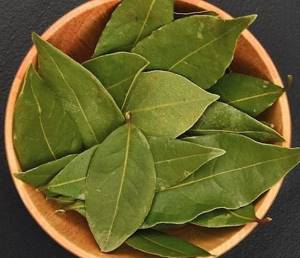
Treatment with laurel leaves requires caution. At the initial stage, you should take 100 ml per day
Birch buds (fresh)
To lower glucose, birch buds are used as follows: three tablespoons are brewed overnight in a half-liter thermos. Throughout the next day, drink in small portions 1.5 hours after meals.
Hazel bark
Long-term use of hazel bark decoction allows you to maintain a stable glycemic level. Dry the bark and grind it to a powder. For a liter jar you need 2 tbsp. l. raw materials. Brew. Leave for 6–8 hours. Boil and let cook for about a quarter of an hour. The dose of the decoction is designed for 2 days. Drink in small portions.
Walnut partitions
Walnut membranes contain substances that inhibit the formation of glucose from saccharides, which helps prevent an increase in blood sugar. 40 grams of partitions must be filled with 500 ml of water. Cook for an hour, without letting the broth boil too much. Cool the medicine and strain the liquid. One dose requires 1–1.5 tbsp. spoons. Drink until all the broth is gone.

